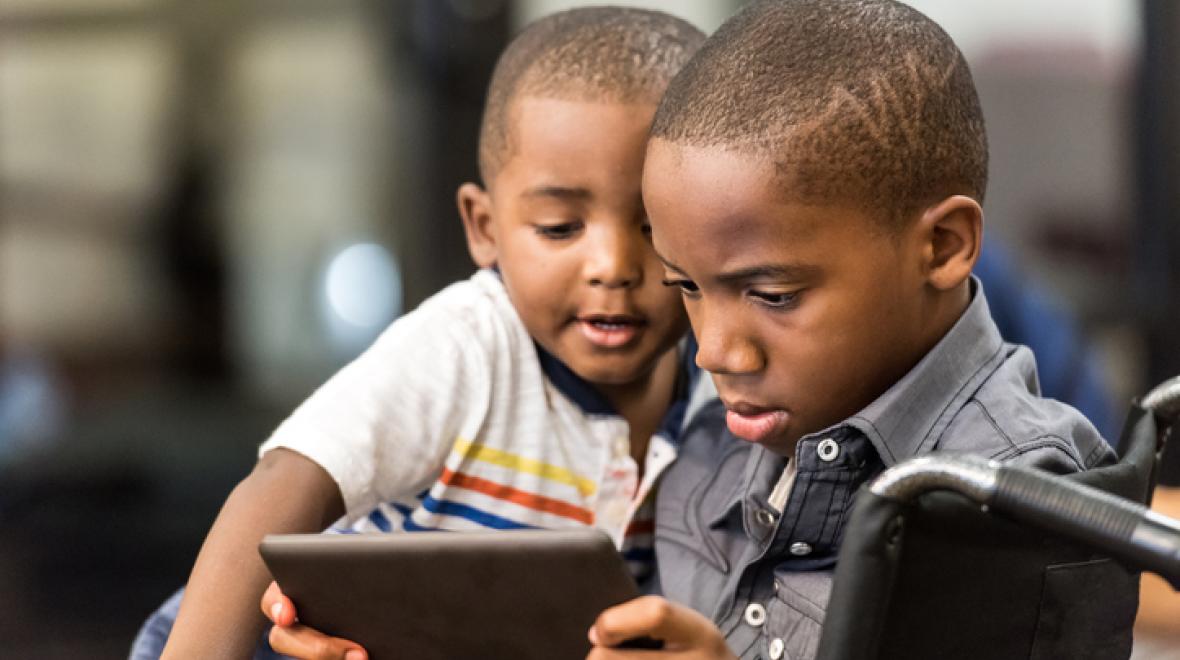
Kids are naturally curious about all kinds of human difference. Particularly if you aren’t disabled yourself (and even if you are), it can be difficult to know how to talk to nondisabled children about disabilities.
How can we talk to our kids about physical and cognitive differences in a way that's honest, destigmatizing and age-appropriate?
Here are a few ideas.
The problem with "don't stare." A tug on the arm and the admonition of "don't stare" is often a child's first exposure to other kids or adults with visible disabilities. While parents who tell their children not to stare or ask questions no doubt mean well and are just trying not to offend anyone, this means that disabilities are first associated for many kids with negativity, fear and avoidance.
This approach doesn't prepare able-bodied kids to integrate disability into their concept of the overall diversity they'll encounter in the world, where any of their friends, teachers and neighbors could be disabled.
Disability studies scholar Heather Gabel warns against the “don’t stare” phenomenon on her blog: “If the cultural norm suggests you ought not look at disabled people because doing so is rude, what are the consequences? The first consequence is that disabled people go unacknowledged, literally ignored.”
Obviously, intrusiveness should be discouraged, but if we’re socialized to believe that even looking at a disabled person is wrong, we learn to associate disability with shame — shame that carries tangible consequences for disabled people in real time, such as social stigma and invisibility.
My husband, who is a wheelchair user, answers young children’s questions about his wheelchair happily (though, of course, like anyone else, he doesn’t always have time to do so as he goes about his day). A parent fearfully grabbing their child away and scolding them is often counterproductive for both the child and their overall perception of disability.
Instead, address your child’s curiosity straightforwardly, answering their questions to the best of your ability. Don’t make assumptions about what the person in question can or can’t do, but do use age-appropriate clinical or matter-of-fact terms, such as “wheelchair” or “Down syndrome.” Encourage them to interact as they would with anyone else, but pretending the disability doesn’t exist is unnecessary.
Language matters. Obviously, disability-related slurs are important to avoid, even in casual conversation or when not directly referencing a disability. Modeling this for your child is important, as they will look to you to learn not only what words to use, but how to think about disability and what it implies about a person’s worth.
On the flip side, don’t be afraid to use the word “disabled” or get too worried about which label is correct. While some advocates, especially parents of disabled children, prefer terms like “differently abled” or person-first language (“person with a disability” rather than “disabled person,” for example), many adult disability rights activists have pushed back against this idea. Since disability is not something to be ashamed of, they argue, and is for many people a matter of pride and/or core identity, it’s not necessary to distance yourself from it.
When in doubt, ask the person in question (if you know them well enough, of course) how they prefer to refer to their disability, or listen to the terms they use to describe themselves. It’s always best to take their lead in describing their identity.
Avoid both pity and "inspiration." In an early episode of ABC’s hit sitcom "Speechless," J.J. DiMeo — a high schooler with cerebral palsy — is frustrated by his reception at his new school. His classmates don’t mock him; in fact, they praise him, calling him “inspirational” and making signs exclaiming “J.J. for President.” The only problem? They don’t even know him! This praise, he knows, is meaningless. They consider him inspirational just for existing with a disability, which also means they probably won’t bother to get to know him as an individual.
While descriptions of disabled individuals as “inspirational,” “innocent” or “angelic” might be well-intentioned, they work to make myths of disabled lives rather than treating them as what they are: human lives, with both struggles and triumphs. Disabled people have difficult relationships, character flaws, and failings (part of what make us human) like anyone else.
Through both expressions of pity and the label of “inspirational,” disabled individuals are often infantilized and even dehumanized. The solution to these dual problems is simple: Treat, and encourage your children to treat, disabled people as individual human beings with individual needs and personalities, rather than as automatic superheroes or as victims requiring pity. Encourage kids to befriend other kids because they genuinely like each other and to get to know each other on an individual basis.
Model the importance of accommodations. Nearly 20 percent of the American population is disabled. What’s more, any of us can become disabled at any time. Disability accommodations are important ways that help disabled people to achieve equality.
A simple way to teach your children respect for accommodations is not to express resentment for them yourself. When the handicapped parking spots are taken or an elevator is full, it can seem harmless to complain, but this contributes to the idea that disability accommodations pose a social burden. Instead, if your child has to wait in line or can’t take a particular seat, try taking a moment to explain the reason.
Don’t assume who is or isn’t disabled. Though the most widely recognized symbol of disability is the wheelchair icon, disability comes in many forms. Neuroatypicality, cognitive disabilities, mental illnesses, chronic pain and many other disabilities are not readily visibly apparent.
What’s more, conversations about disability are often restricted to discussions about able-bodied parents with disabled children. Remember that millions of working adults, parents (of both abled and disabled children), leaders, and authority figures are disabled as well. It’s always good to encourage kids to think outside the box and to consider that we can never tell what someone is experiencing or has experienced just by looking.
The Rise of Anxiety and ADHD: Solutions for Your FamilyThursday, April 26 Author and clinical psychologist, Chris McCurry, Ph.D., provides problem-solving techniques and strategies for helping your child overcome anxiety while recognizing your own. Find out more here |











